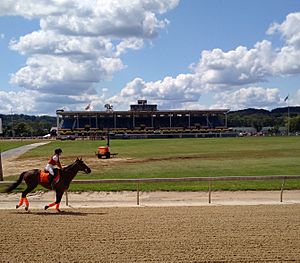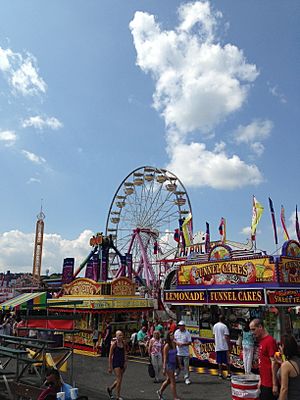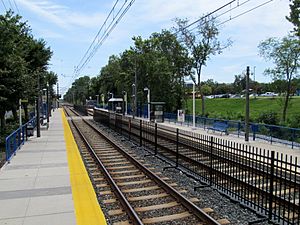Maryland State Fair facts for kids
The Maryland State Fair is a big yearly event in Maryland. It takes place at the Maryland State Fairgrounds in Timonium, Maryland. The fair usually starts in late August and finishes around Labor Day. It lasts for 11 days, offering lots of fun and learning for everyone.
Contents
History of the Maryland State Fair
Early Beginnings of the Fair
The very first fair happened in 1878. It was known as the Lutherville Fair back then. The next year, in 1879, the fair moved to its current home in Timonium. It ran from September 9 to September 12.
In 1906, the Lutherville Fair joined with the Pimlico Fair. Together, they became what we now know as the Maryland State Fair. The fair was put on hold from 1943 to 1945 during World War II. In 1999, the fair grew to its current length of 11 days.
Moving to Timonium
In 1878, a group of Maryland business people held a successful fair. It was on a 4-acre (16,000 m²) site in Lutherville, Maryland. But this fair didn't last long. A new part of the Northern Central Railway was built right through the fairgrounds.
Even so, the fair organizers wanted to keep the yearly fair going. In December 1878, they formed a group called the Agricultural Society of Baltimore County. This group rented a 37-acre (150,000 m²) piece of land. This land was on the old Baltimore and York Turnpike. It was known as "the Timonium Estate."
The first fair at this new spot was held from September 9–12, 1879. The Northern Central Railway became the main way for people to get to the fair. Visitors from Baltimore City could ride the train. Later, people also used electric street cars and then diesel buses. Today, many people drive or use the light rail.
Joining Forces: One Big Fair
Later in the 1800s, the Agricultural Society of Baltimore County had a rival. This was the nearby Pimlico Fair, also called "the State Fair." The two groups held joint fairs in 1894 and 1897. Then, in 1906, they officially merged. They formed one big group called "the Maryland State Fair and Agricultural Society of Baltimore County, Maryland." Their yearly event then became "The Maryland State Fair."
Fair Attractions Through the Years
In the early years, the fair used tents and wooden buildings. These showed off home arts, farm products, and animal shows. Plowing contests with oxen were very popular. Horse races were held at the track. Results were even sent by carrier pigeon! Food was simple, often sandwiches made by farmers' wives. Fun activities included sideshows, sack races, and climbing greased poles.
The Maryland State Fair grew over time. It added many new attractions and exhibits. In 1918, there was even an airmail delivery at the fair! The fair continued until 1943. It was stopped because of World War II. The fairgrounds were used by the U.S. Army for storage and vehicle repairs. After three years, the fair reopened in 1946.
In 1999, the fair added another day, making it an 11-day event. In 2020, the fair was different due to the COVID-19 pandemic. It only had private livestock shows and online events.
Timonium Race Track
 |
|
| Location | Maryland State Fair, at York Road & Timonium Road, Timonium, Maryland United States |
|---|---|
| Owned by | Maryland State Fair & Agricultural Society, Inc. |
| Date opened | September 9, 1879 |
| Course type | Flat |
| Notable races | "Alma North Stakes" "Taking Risks Stakes" |
Saving the Fairgrounds
In the 1950s, Baltimore County grew a lot. Some businesses wanted to buy the fairgrounds for factories. The main owner of the fair corporation, the Maryland Jockey Club, agreed to sell. But many people wanted to save the fair.
A group of farmers, business leaders, horse owners, and bankers formed the "Save the Maryland State Fair Committee." They raised over $600,000. This money helped them buy the fairgrounds. This made sure the Maryland State Fair could keep happening in Timonium. It remained Maryland's biggest event at the end of summer.
Keeping Horse Racing Alive
In the 1970s, another challenge came up. The horse racing industry wanted to move the fair's Thoroughbred races to other tracks. They thought this would help their declining audience. But fair leaders knew this would hurt the fair's survival.
So, the "Committee of Friends of the Maryland State Fair" was created. They worked to strengthen the bond between Maryland agriculture and horse breeding. This connection had been a tradition since the mid-1700s. The Committee successfully showed the public and state lawmakers how important horse racing was to the fair. They also made plans to expand the fair. This led to a $5 million grant from Maryland. This money helped build new things and update the fairgrounds for year-round use.
Famous Horses at Timonium
One very famous horse to race at Timonium was Bee Bee Bee. This Maryland-bred colt won a race here in the fall of 1971. Then, in May 1972, he won the Preakness Stakes at Pimlico Race Course. The Preakness is a major race in the Triple Crown of Thoroughbred Racing series.
Today, the racetrack hosts races during the fair. These include the "Alma North Stakes" for young female horses (called fillies) and adult female horses (called mares). It also hosts the "Taking Risks Stakes."
Miss Maryland Agriculture Program
The Miss Maryland Agriculture Program (MMAP) has been a part of the Maryland State Fair since the 1930s. The name of the contest has changed over the years. When it first started, the winner was called Miss Timonium Fair. Winners have also been known as Farm Queen. Now, the winner receives the title of Miss Maryland Agriculture.
Phyllis McKenzie, who won in 2012, explained the program. She said it's a "knowledge contest" run by the farm bureau. Judges look for contestants to know a lot about different parts of agriculture. They also want to see knowledge about the Maryland Farm Bureau's policies and programs for farmers.
Timonium Fairgrounds Light Rail Service
In the early 1990s, the Baltimore Light Rail line was finished. This train line connects different parts of Maryland. It goes from Cromwell Station in Anne Arundel County, Maryland to downtown Baltimore and up to Hunt Valley, Maryland.
The light rail line has a stop called Timonium Fairgrounds station. This station is right next to the fair's west entrance. Because of this, many more visitors started coming to the fair by train in recent years. This is similar to how people used to arrive by old street cars and commuter trains a century ago.
- Map: 39°26′41″N 76°37′48″W / 39.44472°N 76.63000°W



